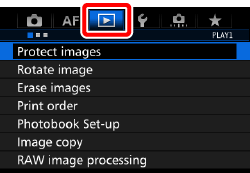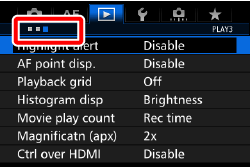Solution
A histogram is a graph that shows the frequency distribution of an image's data values, which makes it convenient for checking an image's brightness or darkness or the trends in the colors it uses.
With this camera, you can use the histogram to check the following.
- Brightness Display: Trends in exposure levels and overall gradations .
- RGB Display: Color saturation and gradation.
For information on how to display the histogram, please refer to the 'Related information' section at the bottom of the page..
Note that you can switch between the [Brightness] and [RGB] displays using [

: Histogram disp.] in the playback menu.
This histogram is a graph showing the distribution of each primary color’s brightness level in the image (RGB or red, green, and blue). The horizontal axis indicates the color’s brightness level (darker on the left and brighter on the right), while the vertical axis indicates how many pixels exist for each color brightness level. The more pixels there are toward the left, the darker and less prominent the color. The more pixels there are toward the right, the brighter and denser the color. If there are too many pixels on the left, the respective color information will be lacking. If there are too many pixels on the right, the color will be too saturated with no gradation. By checking the image’s RGB histogram, you can see the color’s saturation and gradation condition, as well as white balance inclination.
Changing the Histogram Display
To switch between the [Brightness] and [RGB] displays, follow the procedure below.
1. Set the camera’s power switch to < ON >.
2. Press the < MENU > button to display the menu screen.
3. Press the <

> button and select the [

] tab.
4. Turn the <

> dial to select the [

] tab.
5. Turn the <

> dial to select [Histogram disp.], then press <

>.
6. Turn the <

> dial to select [Brightness / RGB], then press <

>.
 : Histogram disp.] in the playback menu.
: Histogram disp.] in the playback menu.





 > button and select the [
> button and select the [  ] tab.
] tab.

 > dial to select the [
> dial to select the [  ] tab.
] tab. 

 > dial to select [Histogram disp.], then press <
> dial to select [Histogram disp.], then press < >.
>.

 > dial to select [Brightness / RGB], then press <
> dial to select [Brightness / RGB], then press < >.
>. 